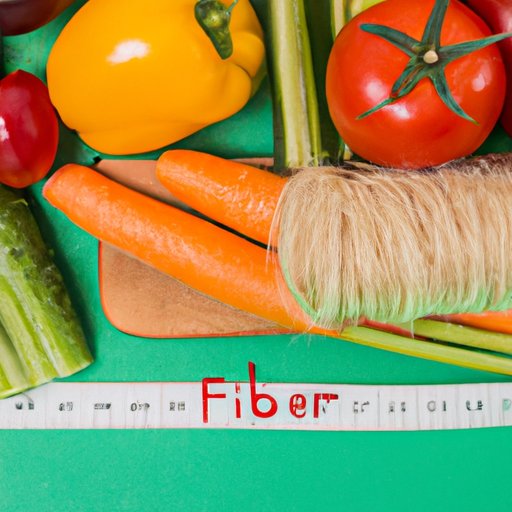
I. Introduction
Weight loss is a common goal for many people as it can positively impact overall health. Fiber is one nutrient that has been suggested to aid in weight loss. However, many people wonder if this is actually true. In this article, we will explore the relationship between fiber and weight loss to determine if fiber can indeed make you lose weight.
II. The Relationship Between Fiber and Weight Loss: A Comprehensive Guide
Fiber is a type of carbohydrate that cannot be digested by the body. There are two main types of fiber; soluble and insoluble. Soluble fiber dissolves in water and forms a gel-like substance in the gut. Insoluble fiber, on the other hand, adds bulk to the stool, promoting regular bowel movements.
When it comes to weight loss, soluble fiber is the star. This is because it promotes feelings of fullness by delaying stomach emptying, reducing overall calorie intake. This makes it easier to stick to a calorie-controlled diet.
Some fiber-rich foods that are great for weight loss include; fruits, vegetables, whole grains, beans, nuts, and seeds. They are low in calories, high in fiber, and thus, make a great addition to any weight loss plan.
III. Adding Fiber to Your Diet: A Simple Method to Shed Pounds
Incorporating more fiber into your diet can be easy and sustainable. One practical way to do this is by replacing refined carbs with whole grains. For instance, swap white bread for whole-grain bread, white rice for brown rice, and regular pasta for whole-grain pasta.
Eating more fruits and vegetables is also a great way to increase fiber intake. Aim for at least five servings of fruits and vegetables each day, and try to consume a variety of colors to get a range of nutrients into your diet.
As you begin to increase your fiber intake, remember to do it gradually. This will help you avoid digestive discomfort like bloating, gas, and cramping.
IV. The Science Behind Fiber and Its Role in Weight Loss
Studies have shown that increasing fiber intake can lead to weight loss. In one study, participants who consumed more soluble fiber lost more weight and body fat, and felt fuller than those who did not. This is because fiber can reduce calorie intake by promoting feelings of fullness, leading to a reduction of overall caloric intake.
Fiber also slows down the absorption of nutrients, including carbohydrates, which can help regulate insulin levels and reduce cravings for sugary, high-calorie snacks.
V. Fiber: The Secret Weapon for Losing Weight and Keeping It Off
Including fiber in your diet can lead to long-term benefits for weight management. Because fiber promotes feelings of fullness, it can help reduce overall caloric intake and maintain a healthy weight over time. Plus, increasing fiber intake can improve digestion, regulate blood sugar levels, and reduce the risk of chronic diseases such as heart disease, type 2 diabetes, and certain cancers.
VI. How Fiber Can Help You Achieve Your Weight Loss Goals
There are several evidence-based strategies for using fiber as part of a sustainable weight loss plan. First, aim to consume at least 25 grams of fiber per day for women and 38 grams of fiber per day for men. Secondly, try to eat whole foods instead of processed foods, and focus on including more fiber-rich plant foods in your diet, as mentioned before. It’s also a good idea to keep track of your daily food intake and to plan your meals in advance to ensure you are getting adequate fiber from a variety of sources.
The key to success when using fiber for weight loss is to be patient and consistent. Gradual changes rather than overnight transformations can make all the difference in reaching your weight loss goals sustainably.

VII. Fiber: The Nutrient That Can Help You Lose Weight Without Sacrificing Taste
Many people believe that high-fiber foods are bland and unappetizing. However, this does not have to be the case. There are so many delicious and easy ways to incorporate fiber into your diet, from smoothies to fiber-rich snacks. Here are some recipe ideas that are high in fiber and will satisfy your taste buds:
- Berry smoothie bowl: blend frozen berries, Greek yogurt, and avocado for a filling and nutritious breakfast
- Chia seed pudding: mix chia seeds, almond milk, vanilla extract, and honey for a creamy and high-fiber snack
- Veggie stir-fry: sauté your favorite vegetables with quinoa or brown rice for a high-fiber, filling meal
VIII. Fiber 101: What You Need to Know About this Potent Aid to Weight Loss
In summary, adding fiber to your diet can aid in weight loss by promoting feelings of fullness, reducing calorie intake, and regulating blood sugar levels. The key to success is to gradually increase fiber intake and include a variety of fiber-rich foods in your diet, such as whole grains, fruits, and vegetables. Remember that fiber has long-term benefits for weight management and overall health.
IX. Conclusion
Fiber is an essential nutrient that can aid in weight loss and overall health when incorporated into the diet. By focusing on whole foods instead of processed foods and gradually increasing fiber intake, you can reach your weight loss goals and improve your overall health. Remember to have patience and consistency, and you will see the benefits of increased fiber intake in no time.





